Prediction of Boiling Heat Transfer Coefficient for Micro-Fin Using Mini-Channel
Abstract
1. Introduction
1.1. Motivation to Predict Heat Transfer Coefficients for Micro-Fins
1.2. Flow Boiling in Micro-Fins and Mini-Channels
1.3. Predicting Heat Transfer Coefficients Using Machine Learning
1.4. Objective of Study
2. Preliminaries
2.1. Deep Neural Networks
2.2. Gaussian Process Regression
2.3. Fine-Tuning
3. Databases and Methods
3.1. Databases
3.2. Physical Properties
3.3. Method
| Algorithm 1. Algorithm for predicting heat transfer coefficients of target samples | |
| 1: | Input: Dataset of mini-channel; Training dataset Xc correspoznding heat transfer coefficient yc target samples Dataset of micro-fin Training dataset Xf corresponding heat transfer coefficient of yf target samples |
| 2: | Output: Predicted heat transfer coefficients and corresponding uncertainty |
| 3: | /** Standardization */ |
| 4: | for j = do |
| 5: | for i = do /** Standardize */ |
| 6: | |
| 7: | end for |
| for i = do /** Standardize */ | |
| end for | |
| 8: | for i = do /** Standardize */ |
| 9: | |
| 10: | end for |
| for i = do /** Standardize */ | |
| end for | |
| 11: | end for |
| 12: | Create an empty array and |
| 13: | for i’ do |
| 14: | Initialize and train the DNN model based on and yc.☐ |
| 15: | Initialize weight parameters and leading to the output of () layer. |
| 16: | Train the fine-turning model based on initialized weight and and yf.☐ |
| 17: | Initialize and train the GPR model based on output of layer and y. |
| 18: | and |
| 19: | Substitute and respectively. |
| 20: | end for |
| 21: | for i = do |
| 22: | Equation (14) using |
| 23: | Equation (16) using |
| 24: | end for |
| 25: | return |
4. Evaluation
5. Results and Discussion
5.1. Prediction Accuracy Depends on Learning Conditions
5.2. Prediction Accuracy with Less Learning Data
6. Conclusions
- (1)
- In our proposed method, we verified the attainment of high accuracy by introducing dimensionless numbers presumed to exert significant influence on calculated heat transfer coefficients from data. It has been reported that heat transfer coefficients in mini-channels improve as the liquid film thins, and similarly, microfins enhance heat transfer coefficients by facilitating the formation of thin liquid films between fins. Thus, we represented the predominant influence of phase interactions crucial to heat transfer coefficients using dimensionless numbers added to the training dataset. Consequently, by reutilizing the physical insights derived from data in mini-channels as weights, we effectively fine-tuned predictions of microfin characteristics based on thin liquid films.
- (2)
- The results predict that the proposed method using fine-tuning with pre-training on mini-channel data outperformed other methods solely trained on micro-fin data in prediction accuracy. Additionally, under conditions where the training data was reduced compared with pre-training data (mini-channel > micro-fin), the proposed method showed equivalent results to existing methods only in terms of the standard deviation (SD) but outperformed in all other evaluation metrics. Furthermore, the proposed method accurately predicted the decrease in heat transfer coefficients according to the quality of post-dryout data with limited experimental data, confirming the effectiveness of this approach. Hence, it has been confirmed that high heat transfer coefficients not only before dryout obtained from experimental data, but also dryout quality and post-dryout heat transfer coefficients, can be predicted with high accuracy.
- (3)
- We employed SHAP for visualizing the opaque black box of machine learning models. Our findings revealed that fine-tuning mini-channel data to predict heat transfer coefficients for microfins showed significant influence from mini-channels where surface tension played a crucial role. This influence was observed to affect the initial weights of the fine-tuning process, emphasizing the substantial contribution of features related to surface tension and inner diameter in elucidating the relationship.
- (4)
- For future work, we plan to expand the scope of prediction by incorporating flow patterns, different geometries, and gravity directions into the training data. This will allow us to extend the prediction capabilities to conditions and environments where experimental data acquisition is challenging. Furthermore, we plan to continue considering improvements to further enhance prediction accuracy through data augmentation and proposing novel prediction models. By doing so, we aim to support the prediction of heat transfer coefficients and contribute to the development of efficient, innovative technologies.
Author Contributions
Funding
Data Availability Statement
Conflicts of Interest
Acronyms
| ANN | Artificial Neural Network |
| Bo | Bond number |
| DNN | Deep Neural Networks |
| Fr | Froude number |
| GPR | Gaussian Process Regression |
| LLMs | Large Language Models |
| MSE | Mean Squared Error |
| Re | Reynolds number |
| R20 | Ratios of the number of data points within ±20% |
| R30 | Ratios of the number of data points within ±30% |
| Std | Standard deviation |
| SD | Standard deviation |
| SHAP | SHapley Additive exPlanations |
| We | Weber number |
References
- Sei, Y.; Enoki, K.; Yamaguchi, S.; Saito, K. Prediction of Boiling Heat Transfer Coefficients for Mini-Channels. Multiph. Sci. Technol. 2022, 34, 43–65. [Google Scholar] [CrossRef]
- Higashide, S.; Momoki, S.; Shigechi, T.; Mori, H.; Yamagushi, T. Experimental Study on States of Liquid Film on Heat transfer Surface Inside a Horizontal Spirally Grooved Tube during Evaporation. Trans. Jpn. Soc. Refrig. Air Cond. Eng. 2006, 23, 121–132. [Google Scholar]
- Baba, D.; Koyama, S. Experimental Study on Heat Transfer of Low GWP Refrigerant R1234ze(E) in a Micro-fin Tube. Trans. Jpn. Soc. Refrig. Air Cond. Eng. 2011, 28, 457–468. [Google Scholar]
- Momoli, S.; Higashide, S.; Shigechi, T.; More, H.; Yamaguchi, T. Prediction of Evaporation Heat Transfer Coefficient of Refrigerants Inside a Horizontal Spirally Grooved Tube Based on Flow Regime Information. Trans. Jpn. Soc. Refrig. Air Cond. Eng. 2006, 23, 225–235. [Google Scholar]
- Miyata, K.; Mori, H.; Ohishi, K.; Tanaka, H. Boiling Heat Transfer and Pressure Drop of a Refrigerant Flowing Vertically Upward in a Small Diameter Tube. Trans. Jpn. Soc. Refrig. Air Cond. Eng. 2007, 24, 359–369. (In Japanese) [Google Scholar]
- Miyata, K.; Ohishi, K.; Tanaka, H. Boiling Heat Transfer and Pressure Drop of a Refrigerant Flowing Vertically Downward in a Small Diameter Tube. Trans. Jpn. Soc. Refrig. Air Cond. Eng. 2007, 24, 371–380. [Google Scholar]
- Enoki, K.; Mori, H.; Kariya, K.; Hamamoto, Y. Boiling heat transfer and pressure drop of a refrigerant flowing vertically upward in small rectangular and triangular tubes. Heat Transf. Eng. 2013, 34, 966–975. [Google Scholar] [CrossRef]
- Enoki, K.; Miyata, K.; Kariya, K.; Hamamoto, Y. Boiling heat transfer and pressure drop of a refrigerant flowing in small horizontal tubes. In Proceedings of the Third International Forum on Heat Transfer, Nagasaki, Japan, 29 February 2012; p. IFHT2012-193. [Google Scholar]
- Cavallini, A.; Doretti, L.; Longo, G. Refrigerant vaporization inside enhanced tubes: A heat transfer model. Heat Technol. 1999, 17, 222–231. [Google Scholar]
- Diani, A.; Rossetto, L. R1234ze(E) flow boiling inside a 3.4mm ID microfin tube. Int. J. Refrig. 2014, 47, 105–119. [Google Scholar] [CrossRef]
- Tang, W.; Li, W. A new heat transfer model for flow boiling of refrigerants in micro-fin tubes. Int. J. Heat Mass Transf. 2018, 126, 1067–1078. [Google Scholar] [CrossRef]
- Borzunov, A.; Ryabinin, M.; Chumachenko, A.; Baranchuk, D.; Dettmers, T.; Belkada, Y.; Samygin, P.; Raffel, C. Distributed Inference and Fine-tuning of Large Language Models Over The Internet. In Proceedings of the 37th Conference on Neural Information Processing Systems, New Orleans, LA, USA, 10–16 December 2023. [Google Scholar]
- YQui, Y.; Zhou, L.; Kharangate, C.; Kim, S.; Mudawar, I. An artificial neural network model to predict mini/microchannels saturated flow boiling heat transfer coefficient based on universal consolidated data. Int. J. Heat Mass Transf. 2020, 149, 119211. [Google Scholar]
- Zhu, G.; Zhang, D.; Chen, W.; Li, J.; Wen, T. Transfer learning model to predict flow boiling heat transfer coefficient in mini channels with micro pin fins. Int. J. Heat Mass Transf. 2024, 220, 125020. [Google Scholar] [CrossRef]
- Wang, Z.; Wang, C.; Meng, L.; Qui, X.; Hong, J. Prediction of sump oil growth rate towards gravitational settling of produced water in oilfield based on machine learning. Desalination Water Treat. 2024, 317, 100189. [Google Scholar] [CrossRef]
- Quinonero-Candela, J.; Rasmussen, C.E. A Unifying View of Sparse Approximate Gaussian Process Regression. J. Mach. Learn. Res. 2005, 6, 1939–1959. [Google Scholar]
- Wambsganss, M.W.; France, D.M.; Jendrzejczyk, J.A.; Tran, T.N. Boiling Heat Transfer in a Horizontal Small-Diameter Tube. J. Heat Transf. 1993, 115, 963–972. [Google Scholar] [CrossRef]
- Tran, T.; Wambsganss, M.; France, D. Small circular and rectangular channel boiling with two refrigerants. Int. J. Multiph. Flow 1996, 22, 485–498. [Google Scholar] [CrossRef]
- Kew, P.A.; Cornwell, K. Cornwell, Correlations for the prediction of boiling heat transfer in small-diameter channels. Appl. Therm. Eng. 1997, 17, 705–715. [Google Scholar] [CrossRef]
- Bao, Z.; Fletcher, D.; Haynes, B. Flow boiling heat transfer of Freon R11 and HCFC123 in narrow passages. Int. J. Heat Mass Transf. 2000, 43, 3347–3358. [Google Scholar] [CrossRef]
- Kuwahara, K.; Koyama, S.; Hashimoto, Y. Characteristics of Evaporation Heat Transfer and Flow Pattern of Pure Refrigerant HFC134a in a Horizontal Capillary Tube. JSME Int. J. Ser. B 2000, 43, 640–646. [Google Scholar] [CrossRef][Green Version]
- Saitoh, S.; Daiguji, H.; Hihara, E. Effect of tube diameter on boiling heat transfer of R-134a in horizontal small-diameter tubes. Int. J. Heat Mass Transf. 2005, 48, 4973–4984. [Google Scholar] [CrossRef]
- Yamashita, H.; Ueda, Y.; Ishihara, I.; Matsumoto, R. Forced Convection Boiling Heat Transfer of Carbon dioxide in Microchannel. In Proceedings of the 80th JSME General Meeting of Kansai Branch, 2005; pp. 12.7–12.8. (In Japanese). Available online: https://www.jstage.jst.go.jp/article/jsmekansai/2005.80/0/2005.80__12-7_/_article/-char/ja/ (accessed on 18 March 2005).
- Li, M.; Dang, C.; Hihara, E. Flow boiling heat transfer of HFO1234yf and R32 refrigerant mixtures in a smooth horizontal tube: Part I. Experimental investigation. Int. J. Heat Mass Transf. 2012, 55, 3437–3446. [Google Scholar] [CrossRef]
- Yokoyama, S.; Saito, K.; Kato, M. The characteristics of evaporation heat transfer in flowing a circular mini-channel. In Proceedings of the 47th Air Conditioning and Refrigeration Union Lecture, Tokyo, Japan, 17 April 2013; p. 21. (In Japanese). [Google Scholar]
- Wu, X.; Zhu, Y.; Huang, X. Influence of 0° helix angle micro fins on flow and heat transfer of R32 evaporating in a horizontal mini multichannel flat tube. Exp. Therm. Fluid Sci. 2015, 68, 669–680. [Google Scholar] [CrossRef]
- Longo, G.A.; Mancin, S.; Righetti, G.; Zilio, C. Saturated flow boiling of HFC134a and its low GWP substitute HFO1234ze(E) inside a 4 mm horizontal smooth tube. Int. J. Refrig. 2016, 64, 32–39. [Google Scholar] [CrossRef]
- Sempértegui-Tapia, D.F.; Ribatski, G. Flow boiling heat transfer of R134a and low GWP refrigerants in a horizontal micro-scale channel. Int. J. Heat Mass Transf. 2017, 108, 2417–2432. [Google Scholar] [CrossRef]
- Diani, A.; Mancin, S.; Rossetto, L. Flow boiling heat transfer of R1234yf inside a 3.4 mm ID microfin tube. Exp. Therm. Fluid Sci. 2015, 66, 127–136. [Google Scholar] [CrossRef]
- Celen, A.; Cebi, A.; Dalkilic, A. Investigation of boiling heat transfer characteristics of R134a flowing in smooth and microfin tubes. Int. Commun. Heat Mass Transf. 2018, 93, 21–33. [Google Scholar] [CrossRef]
- Diani, A.; Mancin, S.; Cavallini, A.; Rossetto, L. Experimental investigation of R1234ze(E) flow boiling inside a 2.4 mm ID horizontal microfin tube. Int. J. Refrig. 2016, 69, 272–284. [Google Scholar] [CrossRef]
- Padvan, A.; Col, D.; Rosseto, L. Experimental study on flow boiling of R134a and R410A in a horizontal microfin tube at high saturation temperature. Appl. Therm. Eng. 2011, 31, 3814–3826. [Google Scholar] [CrossRef]
- Kuo, C.; Wang, C. Horizontal flow boiling of R22 and R407C in a 9.52 mm micro-fin tube. Appl. Therm. Eng. 1996, 16, 719–731. [Google Scholar] [CrossRef]
- Yang, C.; Hrnjak, P. Effect of straight micro fins on heat transfer and pressure drop of R410A during evaporation in round tubes. Int. J. Heat Mass Transf. 2018, 117, 924–939. [Google Scholar] [CrossRef]
- Kondou, C.; Mishima, F.; Liu, J.; Koyama, S. Condensation and Evaporation of R134a, R1234ze(E) and R1234ze(Z) Flow in Horizontal Microfin Tubes at Higher Temperature. In Proceedings of the International Refrigeration and Air Conditioning Conference, West Lafayette, IN, USA, 14–17 July 2014; p. 1446. [Google Scholar]
- Kondou, C.; Mishima, F.; Koyama, S.; Mishima, F.; Koyama, S. Condensation and Evaporation of Low GWP Refrigerant Mixture R32/R1234zw(E) in Horizontal Microfin Tubes. Jpn. Soc. Rerigerating Air Cond. Eng. 2013, 30, 401–411. [Google Scholar]
- Jige, D.; Sagawa, K.; Iizuka, S.; Inoue, N. Boiling heat transfer and flow characteristic of R32 inside a horizontal small-diameter microfin tube. Int. J. Refrig. 2018, 95, 73–82. [Google Scholar] [CrossRef]
- Jige, D.; Inoue, N. Flow boiling heat transfer and pressure drop of R32 inside 2.1 mm, 2.6 mm and 3.1 mm microfin tubes. Int. J. Heat Mass Transf. 2019, 134, 566–573. [Google Scholar] [CrossRef]
- Bandarra Filho, E.P.; Jabardo, J.M. Convective boiling performance of refrigerant R-134a in herringbone and microfin copper tubes. Int. J. Refrig. 2006, 29, 81–91. [Google Scholar] [CrossRef]
- Longo, G.A.; Mancin, S.; Righetti, G.; Zilio, C. CR245fa Flow Boiling inside a 4.2 mm ID Microfin Tube. IOP Conf. Ser. J. Phys. Conf. Ser. 2017, 923, 012016. [Google Scholar] [CrossRef]
- Jiang, G.; Tan, J.; Nian, Q.; Tang, S.; Tao, W. Experimental study of boiling heat transfer in smooth/micro-fin tubes of four refrigerants. Int. J. Heat Mass Transf. 2016, 98, 631–642. [Google Scholar] [CrossRef]
- Gao, L.; Honda, T. Experiments on Flow Boiling Heat Transfer of Pure CO2 and CO2-Oil Mixtures in Horizontal Smooth and Micro-Fin Tubes. In Proceedings of the International Refrigeration and Air Conditioning Conference, West Lafayette, IN, USA, 17–20 July 2006; p. 770. [Google Scholar]
- Longo, G.A.; Mancin, S.; Righetti, G.; Zilio, C. Comparative analysis of microfin vs smooth tubes in R32 and R410A boiling. Int. J. Refrig. 2021, 131, 515–525. [Google Scholar] [CrossRef]
- Spindler, K.; Müller-Steinhagen, H. Flow boiling heat transfer of R134a and R404A in a microfin heat fluxes. Heat Mass Transf. 2009, 45, 967–977. [Google Scholar] [CrossRef]
- Mancin, S.; Diani, A.; Rossetto, L. R134a flow heat transfer and pressure drop inside a 3.4 mm ID microfin tube. Energy Procedia 2014, 45, 608–615. [Google Scholar] [CrossRef]
- Yoshida, S.; Matsunaga, T.; Hong, H.-P.; Nishikawa, K. Heat Transfer Enhancement in Horizontal, Spirally Grooved Evaporator Tubes. JSME Int. J. 1988, 31, 505–512. [Google Scholar] [CrossRef][Green Version]
- Zhao, X.; Bansal, P. Flow boiling heat transfer analysis of new experimental data of CO2 in a micro-fin. Int. J. Heat Mass Transf. 2013, 62, 638–646. [Google Scholar] [CrossRef]
- Kim, Y.; Cho, J.; Kim, M. Experimental study on the evaporative heat transfer and pressure dro of CO2 flowing upward in vertical smooth and micro-fin tubes with the diameter of 5 mm. Int. J. Refrig. 2008, 31, 771–779. [Google Scholar] [CrossRef]
- Wang, Z.; Luo, L.; Xia, X.; He, N.; Peng, D.; Wu, S. Experimental study on flow boiling heat transfer and pressure drop of R245fa/R141b mixture in a horizontal microfin tube. Int. J. Refrig. 2020, 118, 72–83. [Google Scholar] [CrossRef]
- Iizuka, S.; Jige, D.; Inoue, N. Condition/Evaporation Heat Transfer and Pressure Drop of R410A inside Aluminum Microfin Tubes. Mar. Eng. 2017, 52, 818–825. [Google Scholar] [CrossRef][Green Version]
- Lemmon, E.; Bell, I.; Huber, M.; McLinden, M. NIST Standard Reference Database 23: Reference Fluid Thermodynamic and Transport Properties-REFPROP; Version 10.0; National Institute of Standards and Technology: Gaithersburg, MD, USA, 2018. [Google Scholar]
- Baba, S.; Kawanami, O.; Inoue, K.; Ohta, H. Experiments on Dominant Force Regimes in Flow Boiling Using Mini-Tubes. Front. Heat Mass Transfer 2012, 3, 1–8. [Google Scholar] [CrossRef]
- Ku, H.H. Notes on the use of propagation of error formulas. J. Res. Natl. Bureau Stand. 1966, 70C, 331–341. [Google Scholar] [CrossRef]
- Lundberg, S.; Lee, S. A Unified Approach to Interpreting Model Predictions. In Proceedings of the 31st Conference on Neural Information Processing Systems (NIPS 2017), Long Beach, CA, USA, 4–9 December 2017. [Google Scholar]

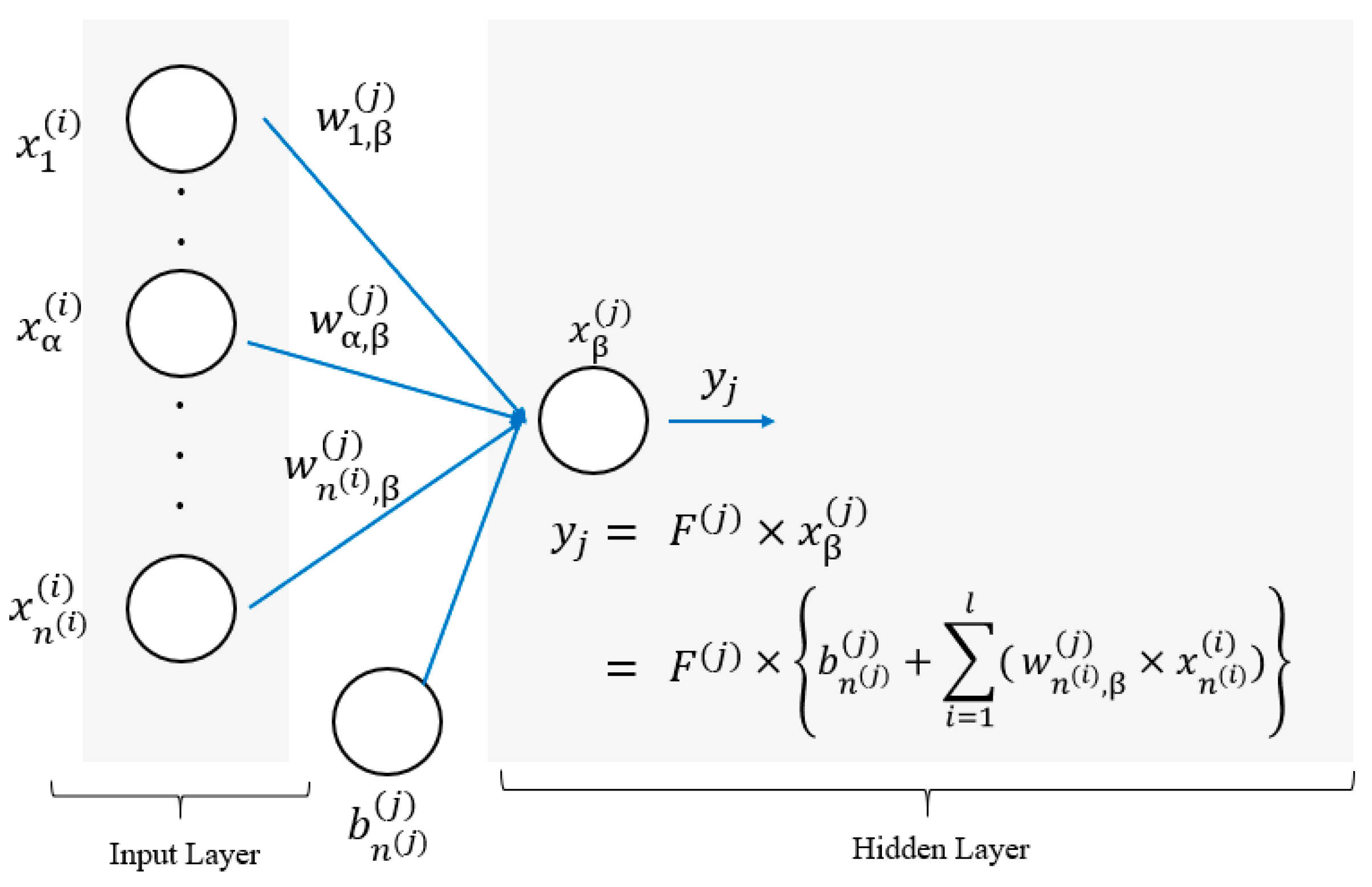
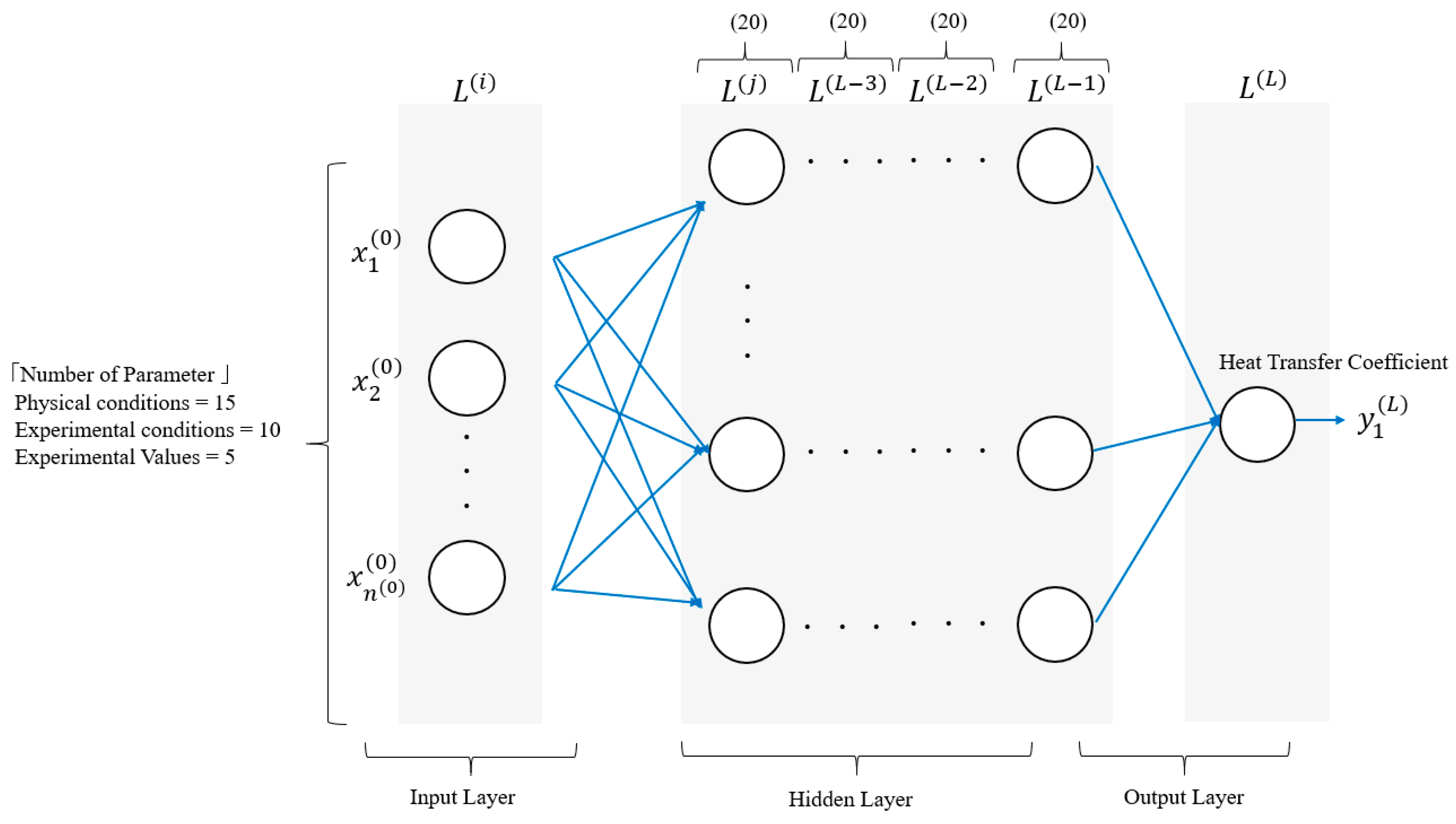
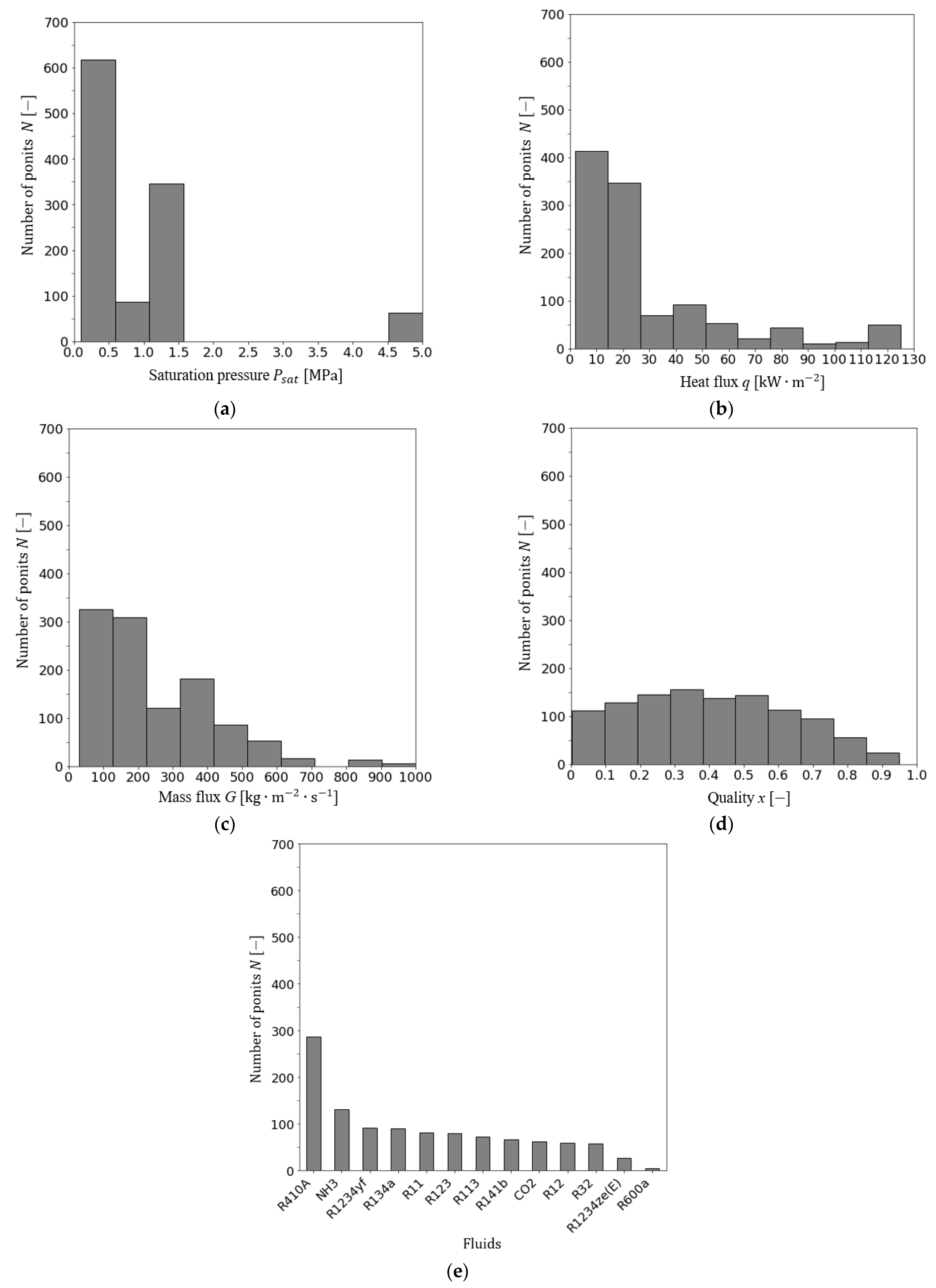
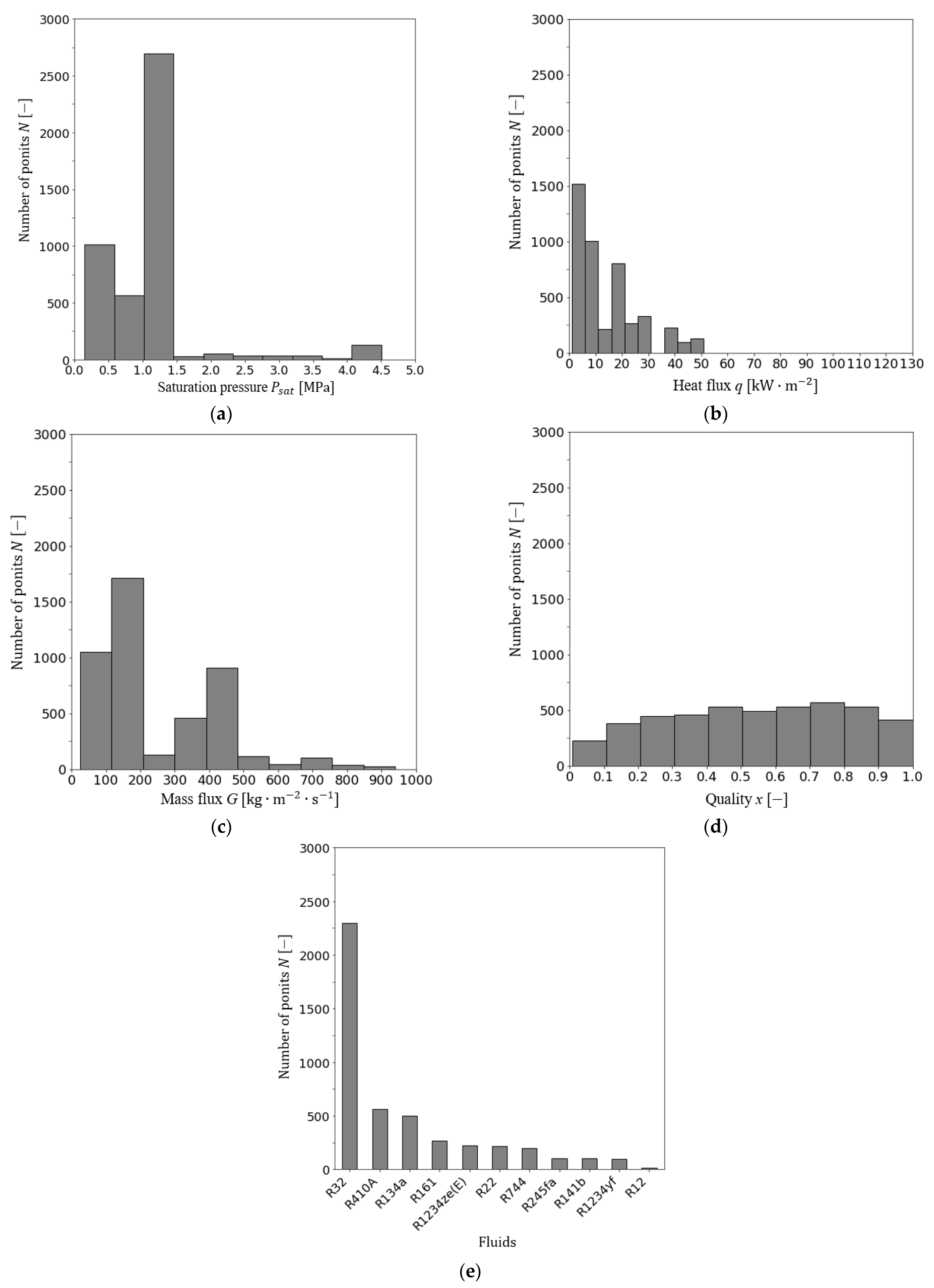




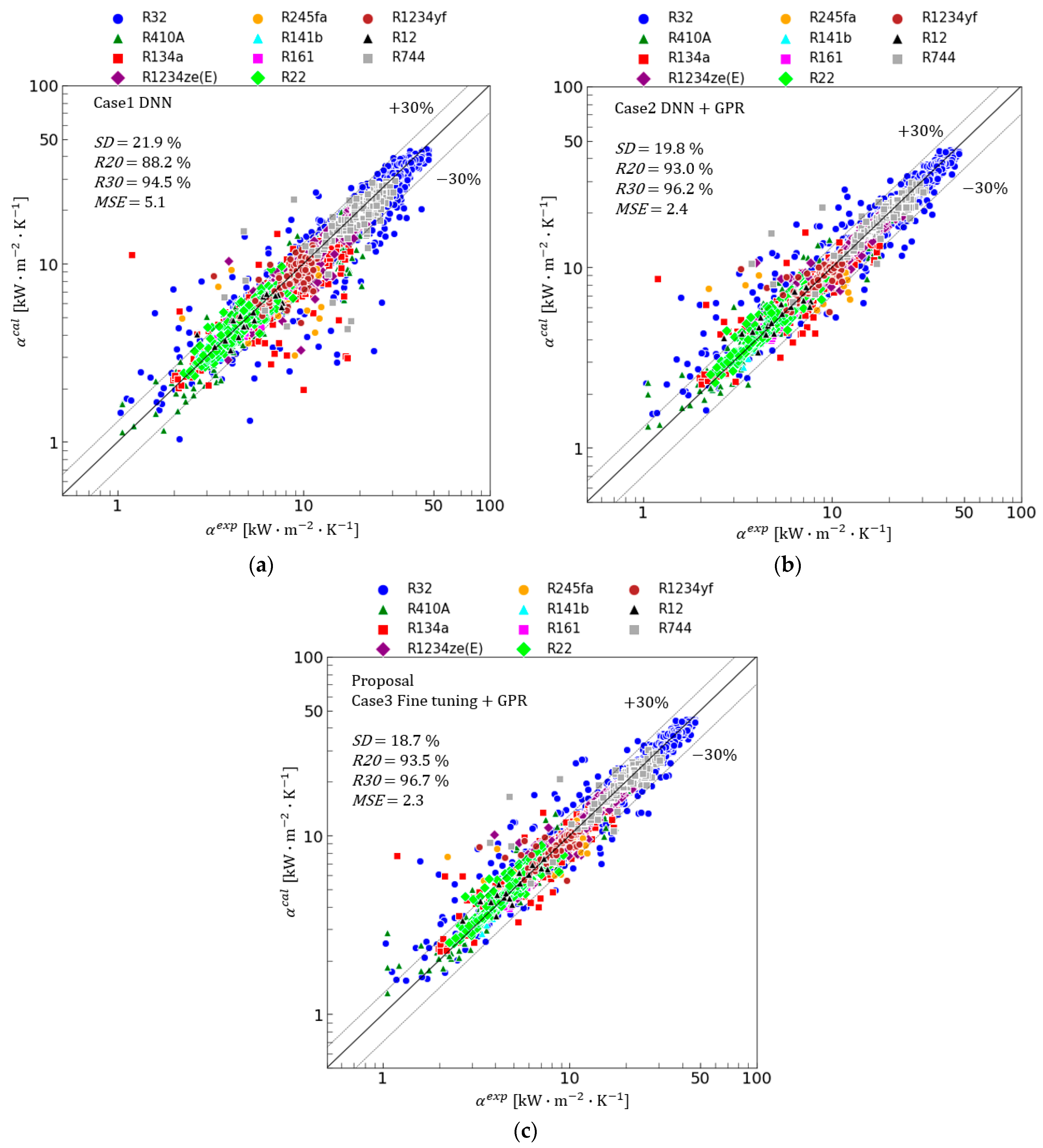
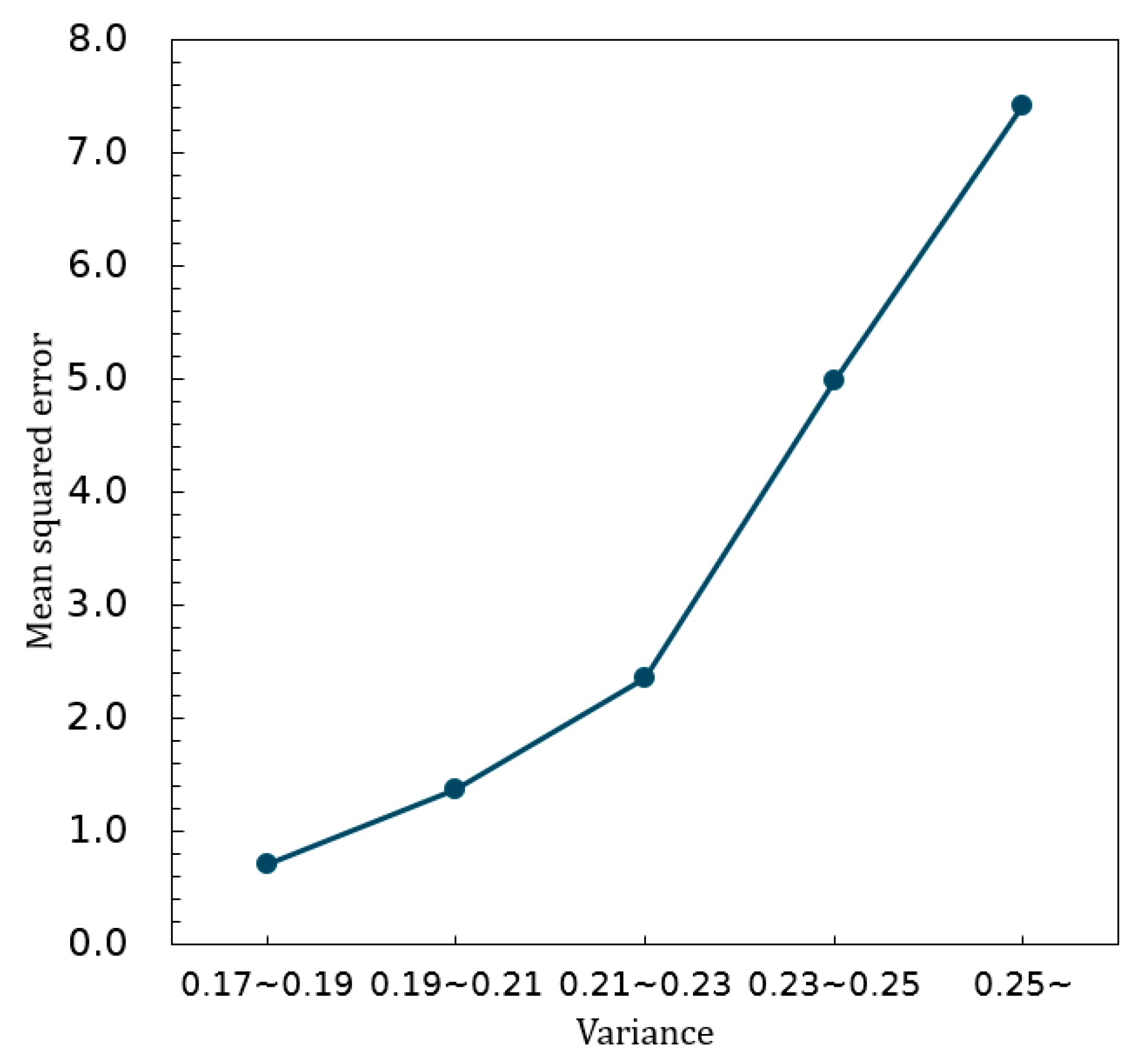
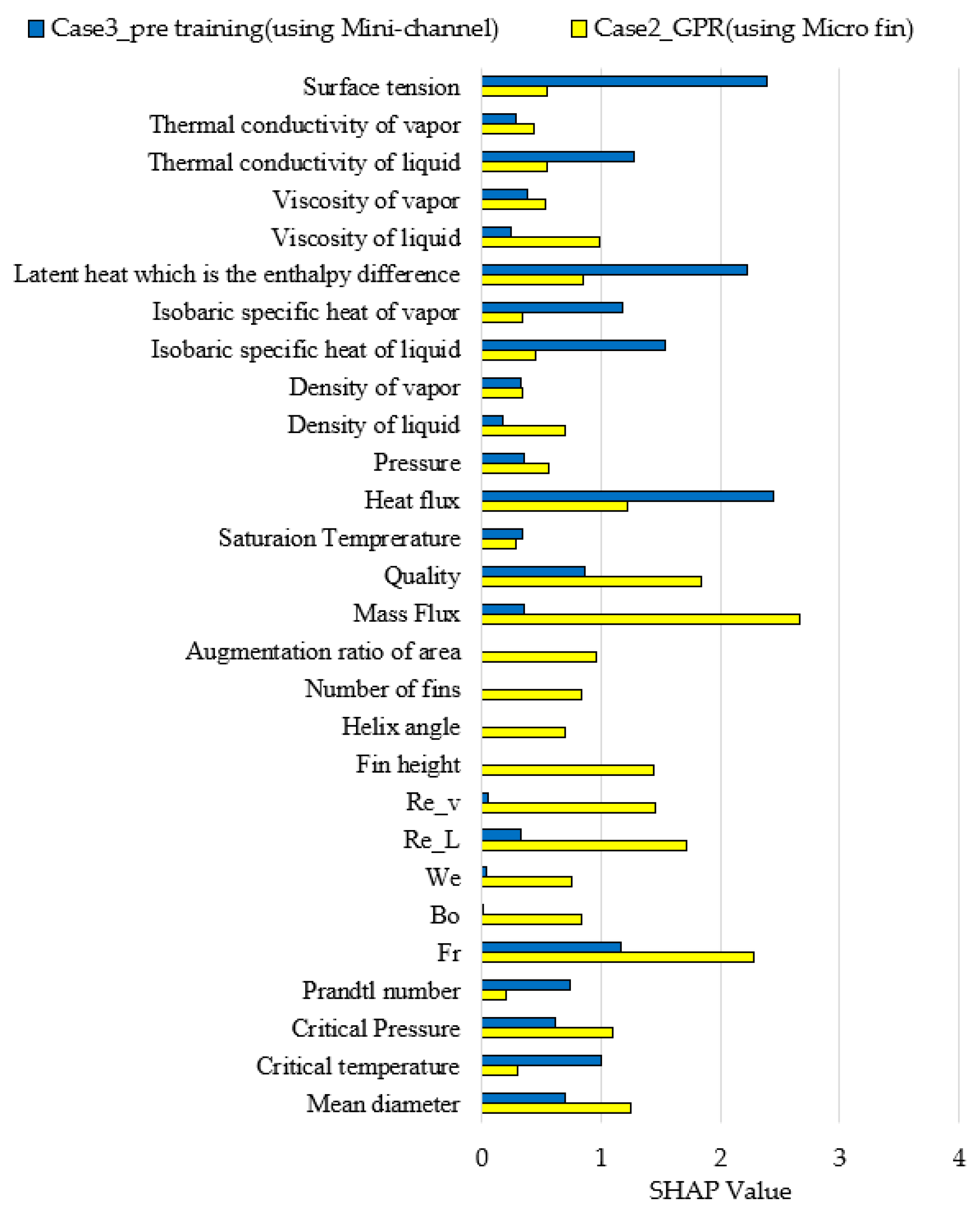
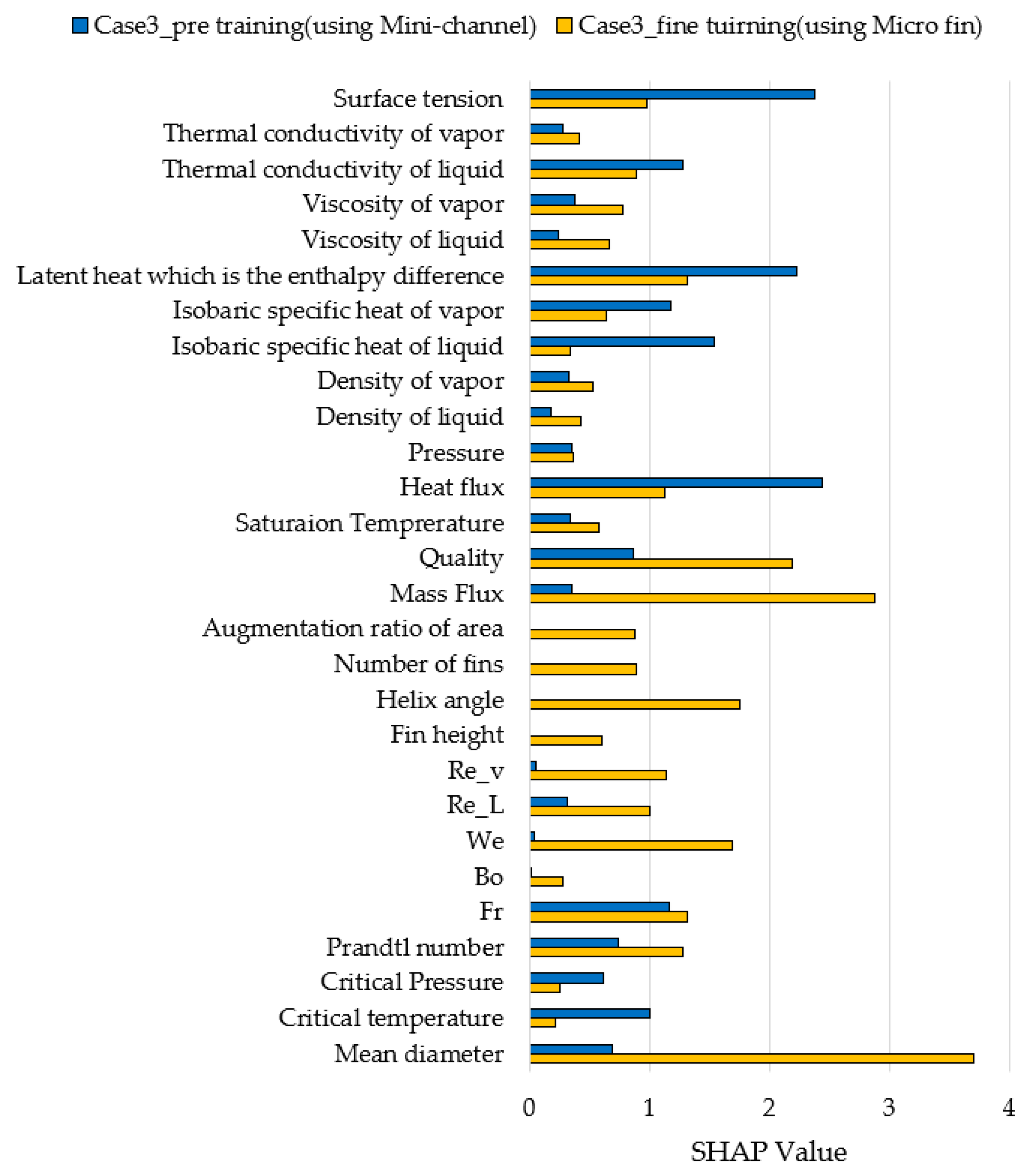

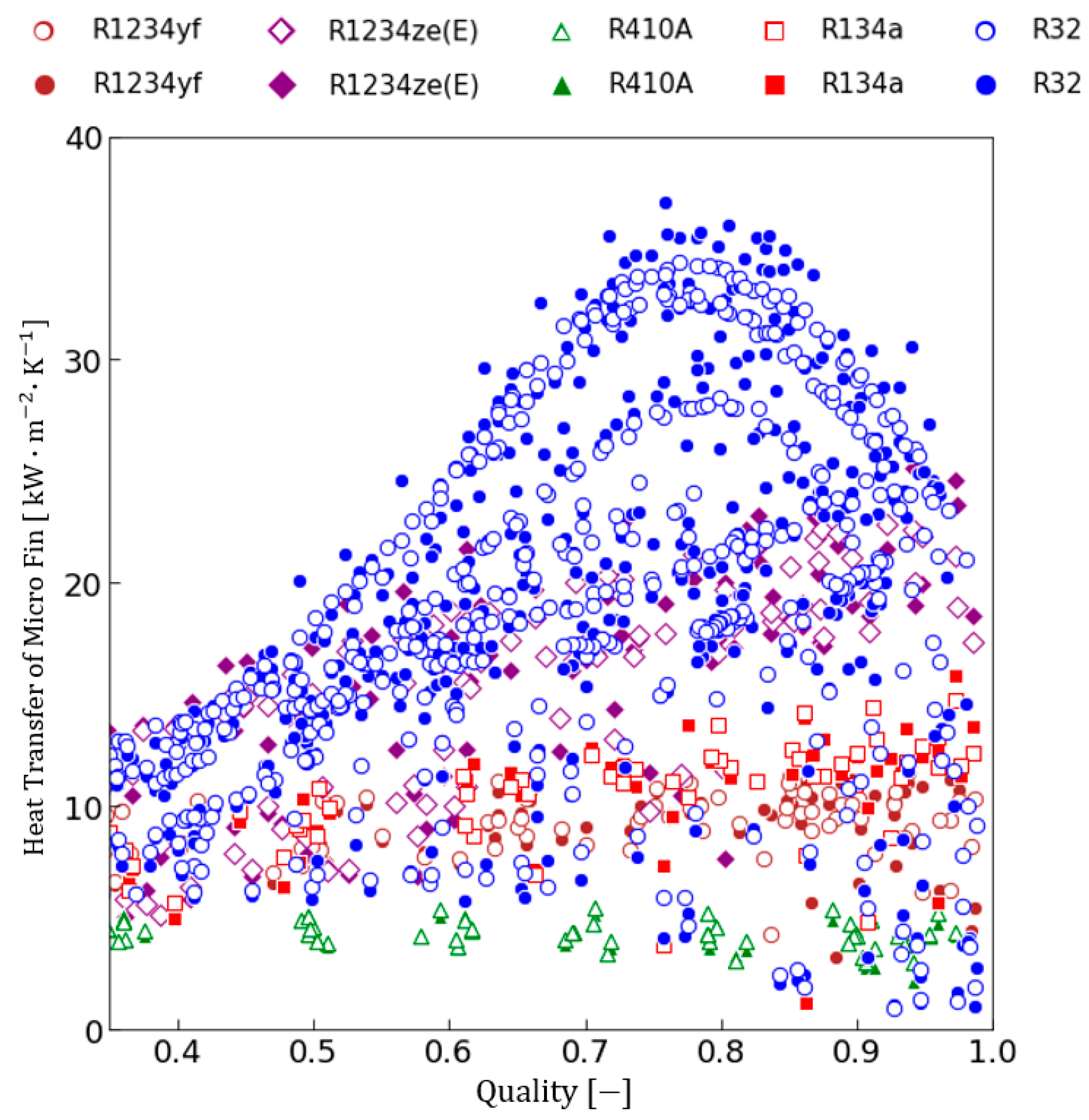
| Source | Fluid | Work Conditions | N |
|---|---|---|---|
| Wambsganss et al. [17] | R113 | = 0.12–0.16, D = 2.92, G = 50–300, q = 8.8–90.8 | 72 |
| Tran et al. [18] | R12 | = 0.83, D = 2.46, G = 66.3–300, q = 7.5–59.4 | 59 |
| Kew et al. [19] | R141b | = 0.10, D = 2.87, 3.69, G = 188–212, q = 9.7–90 | 67 |
| Bao et al. [20] | R11 | = 0.29–0.47, D = 1.95, G = 167–560, q = 52–125 | 81 |
| R123 | = 0.35–0.51, D = 1.95, G = 167–452, q = 39–125 | 80 | |
| Kuwahara et al. [21] | R134a | = 0.88, D = 0.84, G = 552, q = 15.6 | 15 |
| Saitohet et al. [22] | R134a | = 0.41, D = 0.51, 1.12, 3.1, G = 150–300, q = 12–29 | 75 |
| Yamashita et al. [23] | CO2 | = 5.00, D = 1.02, G = 300–1000, q = 30–50 | 62 |
| Li et al. [24] | R32 | = 1.28, D = 2.00, G = 200, q = 4–24 | 44 |
| R1234yf | = 0.51, D = 2.00, G = 100–400, q = 6–24 | 91 | |
| Enoki et al. [8] | R410A | = 1.09, D = 1.00, G = 30–400, q = 2–24 | 287 |
| Yokoyama et al. [25] | NH3 | = 0.43, D = 1.00, G = 100, q = 20 | 132 |
| Wu et al. [26] | R32 | = 1.28, D = 2.00, G = 300, q = 10 | 14 |
| Longo et al. [27] | R1234ze(E) | = 0.31, D = 4.00, G = 200, q = 20 | 15 |
| Sempertgui et al. [28] | R600a | = 0.55, D = 1.10, G = 400, q = 35 | 5 |
| R1234ze(E) | = 0.60, D = 1.10, G = 500, q = 25–35 | 12 | |
| Total | 1111 |
| Source | Fluid | Work Conditions | N |
|---|---|---|---|
| Diani et al. [29] | R1234yf | = 0.78, D = 3.64, G = 190–940, q = 10–50 | 94 |
| Celen et al. [30] | R134a | = 0.49–0.61, D = 8.62, G = 190–381, q = 10 | 47 |
| Diani et al. [31] | R1234ze(E) | = 0.58, D = 2.64, G = 375–940, q = 10–50 | 93 |
| Diani et al. [10] | R1234ze(E) | = 0.58, D = 3.64, G = 190–940, q = 10–50 | 96 |
| Padvan et al. [32] | R410A, R134a | = 0.76–2.42, D = 8.15, G = 80–600, q = 14.7–44.2 | 296 |
| Kuo et al. [33] | R22 | = 0.60, D = 9.32, G = 100–300, q = 6–14 | 24 |
| Yang et al. [34] | R410A | = 1.09, D = 6.52, G = 100–300, q = 10–20 | 66 |
| Kondou et al. [35] | R134a | = 0.77, D = 5.45, G = 150–300, q = 10 | 14 |
| Kondou et al. [36] | R1234ze(E) | = 0.30–1.10, D = 5.37–5.45, G = 200–387, q = 10 | 88 |
| Jige et al. [37] | R32 | = 1.28, D = 3.61, G = 50–400, q = 5–20 | 593 |
| Jige et al. [38] | R32 | = 1.28, D = 2.18–3.14, G = 50–400, q = 2.5–40 | 1609 |
| Bandarra Filho et al. [39] | R134a | = 0.35, D = 8.92, G = 100–500, q = 5 | 87 |
| Longo et al. [40] | R245fa | = 0.18, D = 4.5, G = 100–300, q = 30 | 26 |
| Jiang et al. [41] | R22 | = 0.35–0.94, D = 8.96, G = 250, q = 12.5 | 27 |
| Honda et al. [42] | R744 | = 4.50, D = 3.26, G = 190–770, q = 10–30 | 126 |
| Longo et al. [43] | R32 | = 0.93–1.47, D = 4.50, G = 200–600, q = 12–51 | 88 |
| Spindler et al. [44] | R134a | = 0.57, D = 8.92, G = 25–150, q = 1–15 | 90 |
| Mancin et al. [45] | R134a | = 0.77, D = 3.64, G = 190–755, q = 10–50 | 54 |
| Yoshida et al. [46] | R22 | = 0.40–0.59, D = 11.88, G = 50.1–507, q = 5–30 | 38 |
| Zhao et al. [47] | R161 | = 0.37–0.64, D = 6.41, G = 100–250, q = 28.15–49.29 | 197 |
| Jin Kim et al. [48] | R744 | = 3.05–3.97, D = 4.5, G = 212–530, q = 15–45 | 72 |
| Wang et al. [49] | R245fa, R22, R141b, R161 | = 0.15–0.64, D = 6.41–8.72, G = 100–306.6, q = 7–49.29 | 412 |
| Iizuka et al. [50] | R410A | = 1.08, D = 6.7–6.8, G = 100–300, q = 5–20 | 346 |
| Total | 4583 |
| Case 1 | Case 2 | Case 3 (Present) | |
|---|---|---|---|
| DNN | ✓ | ✓ | ✓ |
| GPR | - | ✓ | ✓ |
| Pre-training | - | - | ✓ |
| Consideration of physical mechanisms | - | - | ✓ |
| Visualization | - | - | ✓ |
| DNN, Case 1 | DNN + GPR, Case 2 | Fine-Tuning and Consideration of Physical Mechanisms, Case 3 (Present) | |
|---|---|---|---|
| SD | 21.9 | 19.8 | 18.7 |
| R20 | 88.2 | 93.0 | 93.5 |
| R30 | 94.5 | 96.2 | 96.7 |
| MSE | 5.1 | 2.4 | 2.3 |
| SD [%] | R20 [%] | R30 [%] | MSE | |
|---|---|---|---|---|
| 0~5.0 | 18.6 | 93.0 | 96.4 | 2.7 |
| 5.0~20.0 | 19.3 | 93.7 | 97.0 | 2.7 |
| 20.0~30.0 | 16.6 | 93.1 | 96.2 | 2.2 |
| 35.0~50.0 | 12.1 | 94.3 | 96.4 | 0.6 |
| SD [%] | R20 [%] | R30 [%] | MSE | |
|---|---|---|---|---|
| 0~250 | 20.5 | 92.3 | 96.2 | 2.5 |
| 250~500 | 15.0 | 95.9 | 97.8 | 1.9 |
| 500~750 | 8.6 | 96.2 | 98.7 | 1.0 |
| 750~1000 | 16.5 | 94.0 | 96.4 | 2.7 |
| DNN, Case 1 | DNN + GPR, Case 2 | Fine-Tuning and Consideration of Physical Mechanisms, Case 3 (Present) | |
|---|---|---|---|
| SD | 23.6 | 25.0 | 24.1 |
| R20 | 89.4 | 92.9 | 93.8 |
| R30 | 94.2 | 95.9 | 96.3 |
| MSE | 4.6 | 2.5 | 2.4 |
Disclaimer/Publisher’s Note: The statements, opinions and data contained in all publications are solely those of the individual author(s) and contributor(s) and not of MDPI and/or the editor(s). MDPI and/or the editor(s) disclaim responsibility for any injury to people or property resulting from any ideas, methods, instructions or products referred to in the content. |
© 2024 by the authors. Licensee MDPI, Basel, Switzerland. This article is an open access article distributed under the terms and conditions of the Creative Commons Attribution (CC BY) license (https://creativecommons.org/licenses/by/4.0/).
Share and Cite
Kinjo, T.; Sei, Y.; Giannetti, N.; Saito, K.; Enoki, K. Prediction of Boiling Heat Transfer Coefficient for Micro-Fin Using Mini-Channel. Appl. Sci. 2024, 14, 6777. https://doi.org/10.3390/app14156777
Kinjo T, Sei Y, Giannetti N, Saito K, Enoki K. Prediction of Boiling Heat Transfer Coefficient for Micro-Fin Using Mini-Channel. Applied Sciences. 2024; 14(15):6777. https://doi.org/10.3390/app14156777
Chicago/Turabian StyleKinjo, Tomihiro, Yuichi Sei, Niccolo Giannetti, Kiyoshi Saito, and Koji Enoki. 2024. "Prediction of Boiling Heat Transfer Coefficient for Micro-Fin Using Mini-Channel" Applied Sciences 14, no. 15: 6777. https://doi.org/10.3390/app14156777
APA StyleKinjo, T., Sei, Y., Giannetti, N., Saito, K., & Enoki, K. (2024). Prediction of Boiling Heat Transfer Coefficient for Micro-Fin Using Mini-Channel. Applied Sciences, 14(15), 6777. https://doi.org/10.3390/app14156777







